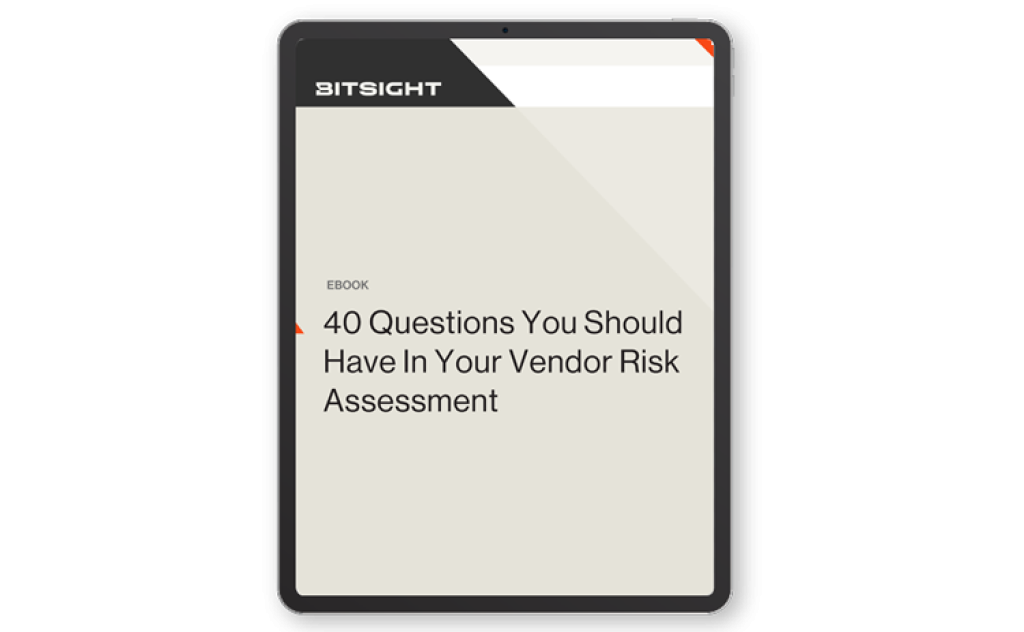With this ebook, we'll help you prioritize which vendors need the most attention with an in-depth security assessment – such as those with low security ratings, or critical vendors that maintain constant contact with your company’s systems.
Sensitive Data: Examples & How to Protect It
Tags:

As a security professional navigating the new challenges constantly cropping up in cybersecurity, it’s critical to understand the ways your organization’s data could be exposed. Safeguarding sensitive information is paramount for organizations across all industries. Whether it's personal data of customers and employees or proprietary business information, the consequences of data breaches can be severe, ranging from financial losses to reputational damage.
What is sensitive information?
Sensitive information refers to data that must be protected from unauthorized access to safeguard the privacy or security of an individual or organization. This encompasses a broad range of data types, including:
- Sensitive personal information (SPI): Such as Social Security numbers, health records, financial account details, and biometric data.
- Business sensitive information: Including trade secrets, proprietary processes, strategic plans, and internal communication.
The classification of data as sensitive often depends on the context and potential impact of its exposure.
Examples of sensitive information
Below, we’ve outlined five examples of sensitive data your organization likely handles—and a few key ways to protect it from evolving cyber threats.
1. Customer information
Customer information is what many people think of first when they consider sensitive data. This could include examples of customer data like:
- Full names
- Home addresses
- Phone numbers
- Payment card information
- Bank account information
- Social security numbers
- Emails
- Health information
- Social media accounts
- Drivers license numbers
- Application attributes, and more
2. Employee data
Employee data is, in many ways, similar to customer information. You have your employee’s names, addresses, and social security numbers, and you may also have their banking information (for payment purposes), usernames and/or passwords used for company logins, or data associated with a credentialing process. This is sensitive information, making it critical for organizations to store it safely. Other examples of sensitive employee data can include:
- Federal Tax IDs
- VISA information
- Veteran and disability data
- Health insurance information
- Confidential data privileges
- Office addresses
A prime example of sensitive data’s real-world vulnerability is the unemployment fraud that occurred during COVID across the US when thousands of fraudulent unemployment claims were filed by hacksters with access to citizens’ private information. This caused disruption not only in individuals’ lives but also internally for companies who were penetrated by hackers seeking employee information they had left unprotected, leaving them vulnerable to financial and operational losses while they worked to help their employees.
3. Intellectual property & trade secrets
Nearly every company has proprietary information stored in their network, with a third party, or in some kind of document management system. If you develop software, this could be code. If you’re a hardware developer, this could be schematics.
This example of sensitive data could also extend to product specifications, competitive research, or anything that would fall under a non-disclosure agreement with a vendor.
Specifically, let’s say company A is developing a phone and company B is helping with a design component. If company B is breached, company A is vulnerable to having sensitive information exposed—which could be catastrophic.
4. Operational & inventory data
This example of sensitive data includes any generalized business operations or inventory figures. For businesses that sell physical products, it’s likely they don’t want sales figures disclosed publicly or accessed by their competitors. Sensitive data is not always personal or individual data, but company-wide information that could impact business decisions, reputation, and operations if exposed.
5. Industry-specific data
Depending on your industry, there may be specific examples of sensitive information you need to protect. Those in retail have to focus on protecting customers’ payment data, whereas those in the healthcare sector have to focus more on protecting digitally-stored medical records, medical research data, to name a few.
This list certainly is not exhaustive, but is meant to get you thinking about what types of information should be considered sensitive data. From obvious examples like proprietary source code, information on a legal case, to seemingly insignificant information on where employees park could all be targeted depending on your organization.
It’s also important to note that customers aren’t always aware they’ve provided you information—or where that information is living. For example, patients in a hospital provide information to their health care providers, but if that information is housed through a third-party, the patient may not know that their personal data is susceptible to risk.
Ultimately, it is up to you and your organization to determine what data is the most sensitive and what can be done to minimize the threats to it.
How do you handle sensitive information or records?
Once you’ve identified the data points you need to protect, it’s time to act. Keep the following things in mind when creating a process for protecting internal data, as well as data stored with third parties.
Effective handling of sensitive information involves a combination of policies, procedures, and technologies:
- Data classification: Identify and categorize data based on sensitivity levels to apply appropriate protection measures.
- Access controls: Implement role-based access to ensure only authorized personnel can access sensitive data.
- Encryption: Use encryption for data at rest and in transit to prevent unauthorized access.
- Employee training: Educate staff on data handling policies and the importance of protecting sensitive information.
- Regular audits: Conduct periodic reviews to ensure compliance with data protection policies.
Which steps should you take before disclosing sensitive information?
Before sharing sensitive data, especially with third parties, consider the following:
- Assess necessity: Determine if sharing the data is essential for business operations.
- Due diligence: Evaluate the third party's data protection measures and compliance with relevant regulations.
- Data minimization: Share only the data necessary for the intended purpose.
- Legal agreements: Establish contracts outlining data usage, protection responsibilities, and breach notification protocols.
- Monitoring: Continuously monitor third-party compliance and data handling practices.
Best practices for protecting sensitive data
Recent studies indicate a sharp increase in cybersecurity threats. For example, the number of data breaches shared on underground forums rose by 43% in 2024. Additionally, underground markets listed nearly 14.5 million compromised credit cards, representing a 20% increase from the previous year, underscoring the growing threats to sensitive personal information. To enhance data protection efforts, organizations should:
- Have the right organizational structure in place: To successfully manage sensitive information you need to have the right cross-organizational team composed of people from different functions and positions. The team works together to identify cyber risks and are proactive about fixing them.
- Develop a data protection strategy: Align data protection goals with business objectives and risk tolerance.
- Make sure the right internal data controls are in place: Every employee in your organization should understand the criticality of cybersecurity for the sake of data protection and overall digital risk protection. You’ll also want to take inventory of who has access to your sensitive data and whether that access is warranted
- Implement data loss prevention (DLP) tools: Utilize technologies that detect and prevent unauthorized data transfers.
- Regularly update security measures: Keep systems and software up to date to protect against emerging threats.
- Establish an incident response plan: Prepare for potential data breaches with a clear action plan to mitigate impact.
- Implement a comprehensive TPRM plan: Third party risk management plans highlight the measures your organization takes to prevent issues caused as the result of third-party or vendor relationships. While every company tries to assess those risks at the outset, you should have an ongoing plan to manage it that includes the following steps:
- Up-to-date list of tiered third parties
- A current cybersecurity assessment of top-tier vendors. You can collect vendor risk assessment data through:
- Vendor questionnaires
- Performing an on-site assessment
- Reviewing documentation
- Performing a penetration test
- A review of current vendor contracts
- Engage in continuous improvement: Regularly review and enhance data protection policies and practices.
By proactively adopting these strategies, organizations can significantly reduce the risk of data breaches and protect sensitive information, maintaining compliance, and ensuring trust among customers and stakeholders.
Start protecting your sensitive data today
Do you know how secure your third party vendors are? Are you meeting all of the global regulatory requirements surrounding the storage of consumer data? Bitsight provides regulatory navigation through today’s complex world to help protect both your sensitive data points as well as your company reputation among peers. Learn more about Bitsight Third Party Risk Management.



